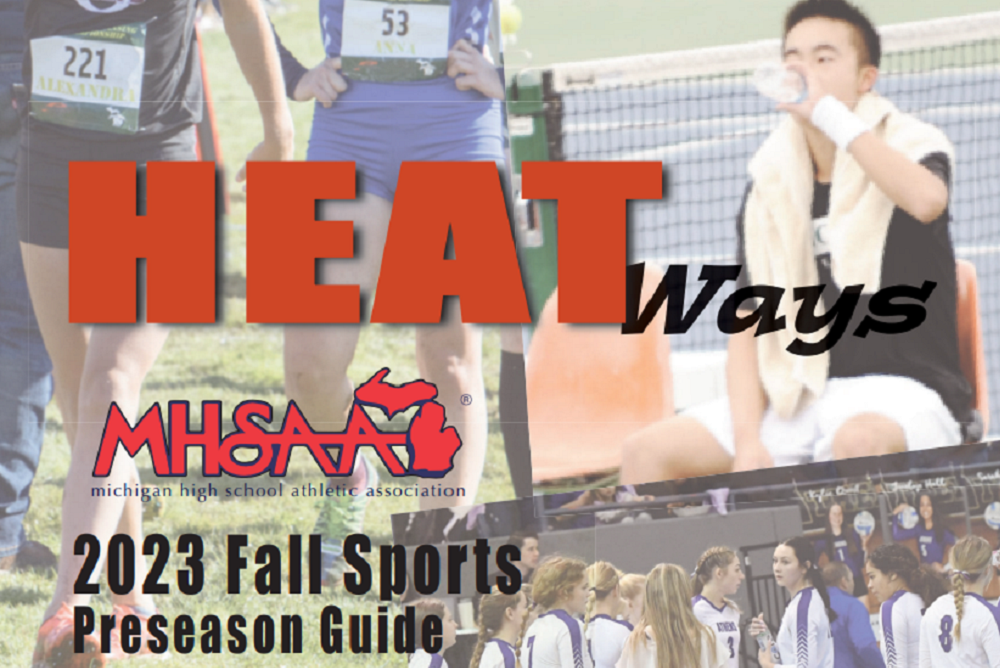
Click for Hot Weather and Hydration Resources
July 24, 2012
The extreme temperatures this Summer in advance of the start of another season of high school sports give cause for concern about physical activity in such conditions, and the Michigan High School Athletic Association continues its role in providing its member schools educational information to assist them in minimizing the possibility of heat-related catastrophic injuries to student-athletes.
The topic of heat-related injuries receives a lot of attention at this time of year, especially when deaths at the professional, collegiate and interscholastic levels of sport occur, and especially since they are preventable in most cases with the proper precautions. In football, data from the National Federation of State High School Associations shows that 35 high school players have died from heat stroke between 1995 and 2010.
Each year, the MHSAA provides information to its member schools to help them prepare for hot weather practice and game conditions in the late Summer and early Fall. Football practice can begin at MHSAA member schools on August 6, followed by all other Fall sports on August 8.
Even before the days of the Internet, the MHSAA was providing resources each Spring to assist schools in their preparation for hot preseason practices. That same information is now available online for all interested parties to utilize, including a link to a free online course, A Guide to Heat Acclimatization and Heat Illness Prevention, produced by the National Federation of State High School Associations. The Health & Safety Resources page of the MHSAA Website has a set of Frequently Asked Questions about dehydration and a page dedicated to hydration and heat illness where preventative steps are outlined, as well as the signs and symptoms of heat illness and action steps to take when it is observed.
Visit MHSAA.com, click on Schools, and then on Health & Safety Resources to find the information.
“Heat stroke is almost always preventable,” said John E. “Jack” Roberts, executive director of the MHSAA. “We know now more than we ever have about when the risk is high and who is most at risk, and we’re fortunate to be able to communicate that information better than ever before to administrators, coaches, athletes and parents. We encourage everyone to avail themselves of the information on our website and through other sources, and to take the online course through the National Federation.”
Roberts added that the first days of formal practices in hot weather should be more for heat acclimatization than the conditioning of athletes, and that practices in such conditions need planning to become longer and more strenuous over a gradual progression of time.
“Then, schools need to be vigilant about providing water during practices, making sure that youngsters are partaking of water and educating their teams about the need for good hydration practices away from the practice and competition fields,” Roberts said.

MHSAA Provides Heat Management Reminders in Advance of 2023 Fall Practices
By
Geoff Kimmerly
MHSAA.com senior editor
August 1, 2023
Temperatures reached record highs in some parts of Michigan at the start of this summer, and heat waves have made headlines nationally over the last month. Although the state didn’t experience similar extremes during July, the beginning of August always is a pertinent time for reminders that more hot weather is likely in many areas and should be prepared for as Michigan High School Athletic Association practices are set to begin Monday, Aug. 7.
Each year, the MHSAA provides information to its member schools to help them prepare for hot weather practice and game conditions during the late summer and early fall. Practices for all Fall 2023 sports – cross country, football, Lower Peninsula girls golf, boys soccer, Lower Peninsula girls swimming & diving, Lower Peninsula boys and Upper Peninsula girls tennis, and volleyball – may begin Monday, Aug. 7.
The “Health & Safety” page of the MHSAA Website has links to several information sources, including the MHSAA preseason publication Heat Ways, which is available for download and includes valuable information on heat management in addition to requirements and resources regarding head injuries and sudden cardiac arrest.
The first days of formal practices in hot weather should be more for heat acclimatization than the conditioning of athletes, and practices in such conditions need planning to become longer and more strenuous over a gradual progression of time. Schools also must consider moving practices to different locations or different times of day, or change practice plans to include different activities depending on the conditions. Furthermore, football practice rules allow for only helmets to be worn during the first two days, only shoulder pads to be added on the third and fourth days, and full pads to not be worn until the fifth day of team practice.
The MHSAA advises student-athletes to make sure to hydrate all day long – beginning before practice, continuing during and also after practice is done. Water and properly-formulated sports drinks are the best choices for hydration.
A number of member schools follow the MHSAA’s Model Policy for Managing Heat & Humidity, which while not mandated for member schools was adopted as a rule for MHSAA postseason competition in 2013. The plan directs schools to begin monitoring the heat index at the activity site once the air temperature reaches 80 degrees, and provides recommendations when the heat index reaches certain points, including ceasing activities when it rises above 104 degrees. (When the temperature is below 80 degrees, there is no combination of heat and humidity that will result in a need to curtail activity.) The model heat & humidity policy is outlined in a number of places on the MHSAA Website, including as part of Heat Ways.

